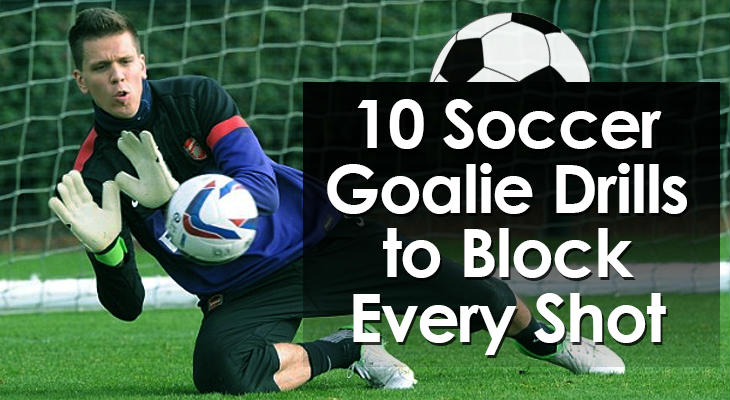12 Soccer Goalie Drills (2024 Update)
Being a goalie in soccer is a very unique position and one of the toughest positions to play.
As a coach, you must find soccer goalie drills that incorporate the goalkeepers into your training sessions.
If you're coaching a young team, chances are that you don't have a specific goalie on the team and instead all players rotate through the position...
Using soccer goalie drills will allow you to determine which of your players is best suited for the role and also which players enjoy filling this role.
Below are 10 soccer goalie drills you can use to implement goalkeeping into your training sessions.
12 Soccer Goalie Drills
1. Agility Hands
How the Drill Works:
A goalkeeper works through a series of cones and sticks before attempting to catch soccer balls that are kicked at them from short distance.
Purpose:
Develops a goalkeeper’s footwork and agility while focuses on soft hands and improving their catching abilities.
Setup:
- It is best to do this in front of a full-size goal for goalkeepers to get more comfortable with their box. Using a goal also keeps the soccer balls close in case a catch is missed. If a goal is unavailable, this drill can be completed without one.
- Set up series of cones in front of the goal. See the diagrams below for different variations.
- Set up two mannequins, about 6-7 yards apart from each other, at the end of the series of cones. If mannequins are not available, cones can also be used.
- One goalkeeper starts on the goal line.
- Two extra goalkeepers, players, or coaches are needed as servers to complete this drill. Have the two servers stand 4-5 yards off each mannequin with a ball in their hands.
- Give each server 3-5 extra soccer balls.
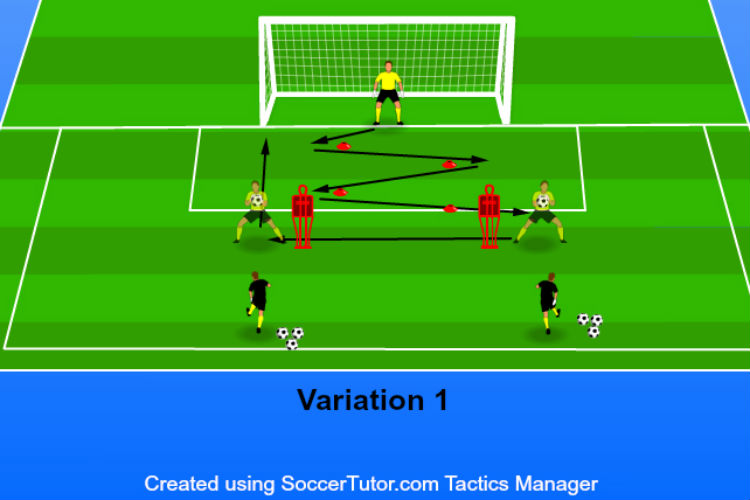
Instructions:
- The goalkeeper in front of the goal begins by quickly moving through the series of cones in front of the goal.
- After completing the series of cones, the goalkeeper quickly moves to the outside of the nearest mannequin.
- As soon as the goalkeeper arrives outside the first mannequin, the server standing behind that mannequin drop kicks the ball towards the goalkeeper’s chest.
- The goalkeeper catches the ball and immediately throws it back to the server before quickly shuffling across to the outside of the other mannequin where they will repeat the same process.
- After throwing the ball back to the second server, the goalkeeper runs backwards, using the proper footwork, to their starting point in front of goal before repeating the same process until they complete 8-12 catches.
- After the goalkeeper completes their round, rest and recover any lost soccer balls. If there is more than one goalkeeper, rotate them in and continue the activity.
- Each goalkeeper should complete three rounds. Switch the footwork used through the series of cones after each round. See diagrams for more information.
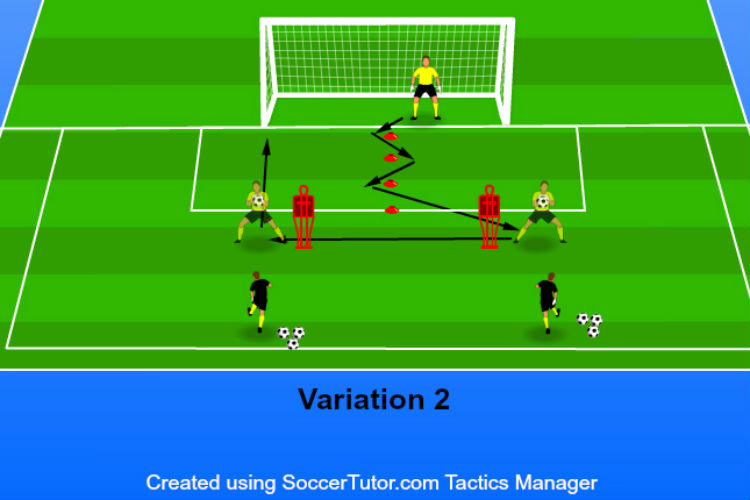
Variations:
Passes instead of catches – Servers pass on the ground and goalkeepers must pass the ball back to the servers in one-touch.
Jumping catches – Servers toss the ball high so the goalkeepers must jump up and catch the ball.
Dive – Servers toss, or pass, the ball wide outside the mannequins to make the goalkeeper dive and collect the ball.
Coaching Points:
- Challenge the goalkeepers to work as quickly as possible when completing their round.
- Teach the goalkeepers to not cross their feet and to take quick, sharp steps when working through the cones.
- Remind the goalkeepers to get their bodies behind the ball when they catch the ball. Goalkeepers should move their feet quickly to move their bodies in to the proper catching position behind the ball.
2. Deflect and Dive
How the Drill Works:
The goalkeeper working attempts to block a low shot at one post before quickly getting up and moving across the goal to block a high shot at the far post.
Purpose:
Develops goalkeepers’ ability to move back and forth across the goal to block shots. Goalkeepers improve their quickness and agility as they attempt to block shots.
Setup:
- One full size goal is needed for the drill.
- One goalkeeper starts on the goal line.
- Three extra players are needed as servers for this activity. If there are not three more goalkeepers, players or coaches can be used to fill in the remaining serving positions.
1. Server #1 will start on the goal end line, 1-2 yards off on of the goal posts.
2. Server #2 will be positioned inside the field, 6-8 yards off the opposite goal post of Server #1.
3. Server #3 will stand inside the field, 8-9 yards away from the center of the goal.
See diagram for more information. - Servers #1 and #3 must have a good supply of soccer balls.
- Decide on the number of soccer balls the goalkeeper will attempt to save before resting. 4-8 soccer balls are ideal.
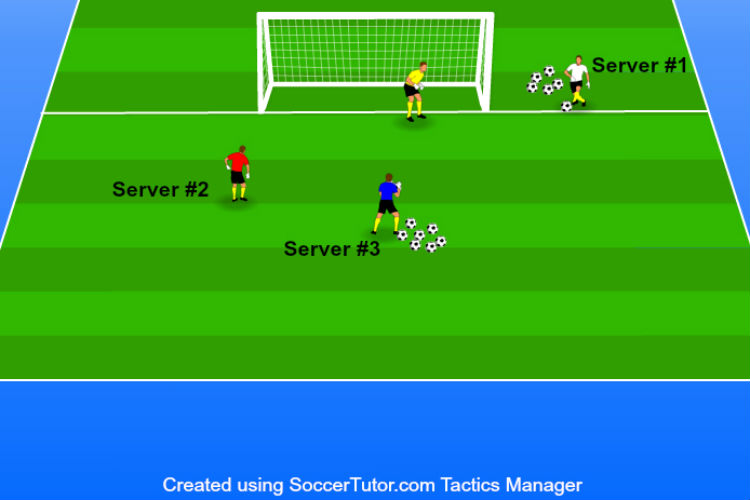
Instructions:
- Server #1 starts the drill with a low pass towards server #2.
- As the ball approaches server #2, the goalkeeper moves towards the receiver to cut off the scoring angles.
- Server #2 takes a low, one-touch shot while the goalkeeper attempts to block the shot using their hands or feet.
- Immediately after the low shot, the goalkeeper gets up and quickly moves towards the other post while server #3 throws a ball high to the post the goalkeeper is moving towards. The goalkeeper dives and attempts to block, or catch the ball.
- Depending on the age, fitness level, and number of goalkeepers present, give the working goalkeeper a few seconds to reset before completing the process again for another 2-3 repetitions. If the goalkeepers are fit, give them no time to reset in-between repetitions. If multiple goalkeepers are present, keep the repetitions to 2-3 before quickly rotating in the next goalkeeper.
- Switch the sides the serves are on after a few rounds so that goalkeepers work on both ways.
- Each goalkeeper should complete 3-6 rounds. Complete more rounds if desired, or if the number of repetitions per round is short.
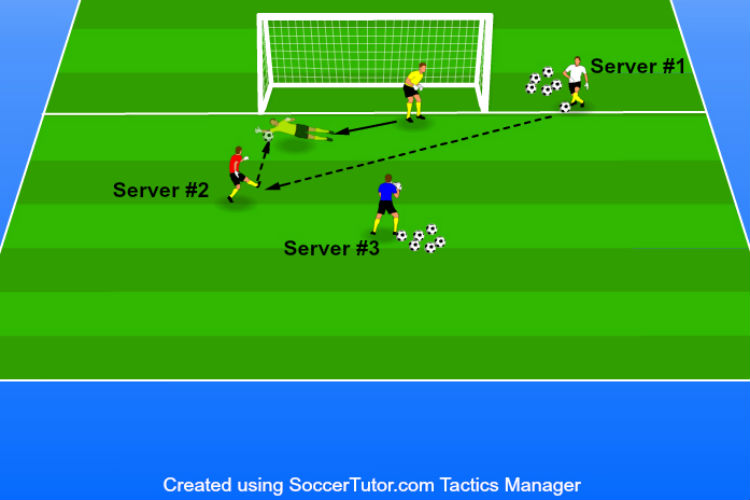
Variations:
Shots – Instead of throws, or light passes, move the servers further away from the goal and have the servers use their feet to shoot on goal. Same pattern as listed above. Shooters should be aiming to put the ball in the same place as listed above as well. This makes the saves more game-like and forces goalkeepers to be faster and stronger on the blocks.
Coaching Points:
- Depending on the goalkeepers’ age and skill level, make sure to spend time on the movements and how to properly cut off the scoring angles before beginning this activity. For younger, less experienced goalkeepers, start slow and focus on the steps and angles before focusing on speed and saves.
- Remind the servers that the first shot should be on the ground while the second one should be high up and almost out of the goalkeepers reach. The shots/tosses should start without too much power. As the goalkeepers improve, increase the power and difficulty of the serves.
- Instruct the goalkeepers to keep their weight forward and react quickly after each ball.
- The goalkeepers should stay square while diving and landing on the ground. The goalkeepers should land on their hip and keep the largest part of their body behind the ball to build good habits.
3. Goalie Wars
How the Drill Works:
Two goalkeepers play against each other attempting to score in the other’s goal. Each goalkeeper can throw, kick, or drop kick the ball at the other goalkeeper in an attempt to score while the other goalkeeper attempts to save the ball.
Purpose:
Fun and competitive game for goalkeepers that develops their footwork, reflexes, agility, distribution, and confidence. Goalkeepers get to compete against each other in a high intensity game.
Setup:
- Set up a 20x15 playing grid using cones. Make sure there is one cone on each sideline of the grid that marks the half way point.
- Set up one full-sized goal on each end line.
- Use a couple of cones to mark a line 5-yards in front of each goal. These two zones are known as the “goalie zones.” The cones should not be in the way of the play, but should be easily seen for the goalkeepers to be aware of.
- One goalkeeper is needed in each of the goals. If there are extra goalkeepers, have them stand off to the side and retrieve any soccer balls that miss the goal. Rotate the goalkeepers after each round.
- A good supply of soccer balls is needed in each of the goals.
- Decide on a time, or score limit for each round and the number of rounds to be completed. 3-4 minutes per round, or first goalkeeper to score 5 goals is a good starting point. Play for 4-6 rounds.
- One goalkeeper starts with the soccer ball.
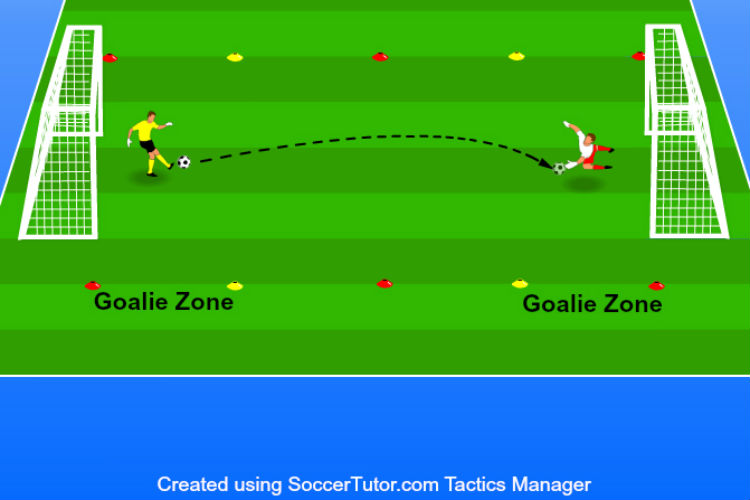
Instructions:
- The goalkeeper starting with the ball stands inside their goalie zone while the other goalkeeper stands inside of theirs. The goalkeeper with the ball attempts to score on the other goalkeeper by throwing, kicking, drop kicking, or volleying the soccer ball towards the other goal. They must make their attempt inside of their goalie zone.
- The defending goalkeeper attempts to make a save on the shot before getting a chance to score on the other goalkeeper.
- If a goalkeeper scores, the goalkeeper who just scored gets to start with a new ball from their goal.
- If a goalkeeper blocks the shot and the ball goes out-of-bounds, the goalkeeper who made the save, starts with a new ball from their goal.
- If the soccer ball hits off a goal post, or the defending goalkeeper gives up a rebound, and the ball rolls back into the shooting goalkeeper’s half, the shooting goalkeeper gets a one-touch shot attempt from anywhere inside their own half.
- The game continues in this manner for the remainder of the round.
- After the round is over, goalkeepers rest and collect any balls that missed the goal. If there are more than two goalkeepers, have them rotate in immediately and begin play. If there are only two goalkeepers present, give the goalkeepers 2-3 minutes of rest before starting the next round.
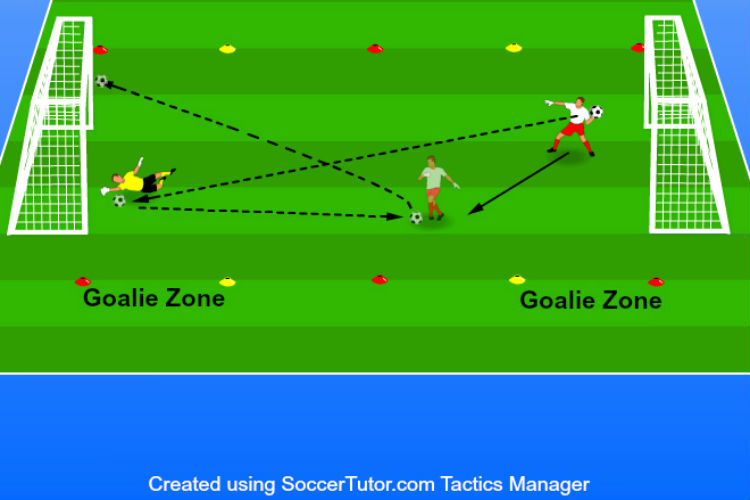
Variations:
2-on-2 – Best for younger goalkeepers. Use the same rules, but have teams of two goalkeepers compete against each other.
Scoring techniques – Change the rules to keep the game new. Allow only kicking from the ground, or only throws, or any other scoring technique to make the game more difficult.
Coaching Points:
- Encourage the goalkeepers to catch as many balls as possible to decrease the amount of second chances the shooting goalkeeper gets.
- Challenge the goalkeepers to score as often as possible and to use different scoring techniques.
- Remind the goalkeepers to stay on their toes to react quickly to the incoming ball and make a save.
- Make sure the goalkeepers have fun and keep it competitive. Motivate and congratulate goalkeepers to keep them working.
4. Goalkeeper Reaction
How the Drill Works:
A goalkeeper must react to two attacking players running behind mannequin defenders looking to receive the ball from the passer and score. The goalkeeper is unaware of which attacking player will be passed to and must move to quickly close them down and make a save on their close-range shot.
Purpose:
Develops goalkeepers’ positioning, quick decision making, and shot stopping. Attackers improve the 1-on-1 finishing abilities with a live goalkeeper as well as their timing of their runs and first touch.
Setup:
- Place three mannequins, flags, or cones 1-3 yards outside of the penalty box. They should be placed parallel to the penalty box line with 5-7 yards between each one. See diagram for picture.
- Place one cone 10-12 yards directly above each mannequin. These cones will the starting points for the three attackers.
- A full-size goal is needed on the end line of the penalty area.
- One goalkeeper is positioned in goal. If there are extra goalkeepers, have them stand to the side of the goal and rotate every 1-2 repetitions.
- At least three extra players are needed as the attackers in this activity. If there are more than three attackers, have them form lines behind the cones and rotate after each repetition. It is best if the attackers are field players.
- Place 4-6 soccer balls with the attacker on the center cone.
- One attacker starts behind each of the three cones. The attacking player on the center cone starts with a ball at their feet.
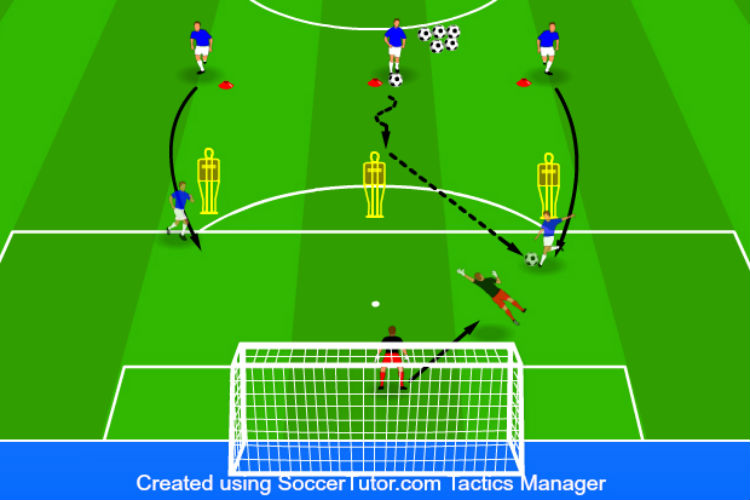
Instructions:
- To start, the attacking player with the ball dribbles towards the mannequins. The goalkeeper starts in front of their goal in good position for a long range shot, or a through ball behind their defense.
- The attackers on the wings, without the ball, begin to make their runs towards the outside mannequins setting themselves up to receive a through ball behind the mannequins.
- The attacker with the ball passes to one of the two attackers running behind the mannequins.
- The goalkeeper immediately moves, while the ball is traveling, towards the attacking player attempting to cut of the scoring angles and get as big as possible.
- The attacking player takes a 1-touch shot, or attempts to receive the pass and dribble around the goalkeeper.
- The goalkeeper reacts to the attacker’s choice and attempts to make a save on the ball.
- The attacking player who receives the through ball, is not allowed to use the other two attackers when attempting to score.
- The attacking players should time their runs to stay onside and make the activity more realistic.
- After a save, or a goal, the players and goalkeeper reset and repeat the process as soon as they are ready. If there are extra goalkeepers, have them rotate after 1-2 repetitions. If there are extra attacking players, have them rotate after every repetition.
- The activity continues until each goalkeeper has completed at least 7-10 repetitions.
Variations:
More attackers – If there are more attacking players, add another attacker to make the goalkeeper react to another attacking position.
Long-range shot – To keep the goalkeepers honest, tell the attacking player who dribbles towards the mannequins that they can take a long-range shot, instead of passing to the other attackers, if they see the goalkeeper is out of position.
Coaching Points:
- Remind the goalkeepers to start in a good position in case a long-range shot is taken. The activity does not call for a long-range shot, but make the goalkeepers stay honest and work on their positioning. The goalkeepers should constantly be moving and adjusting their position.
- Challenge the goalkeeper to make a quick decision and to attack the ball. If the goalkeeper can get to the ball before the attacking player, they should!
- Educate the goalkeepers on proper footwork and to stay on their toes to react quickly to the attacking situation.
- Challenge the attacking players to score as often as possible and give the goalkeeper good practice.
- Remind the attacking players to try and stay onside with their runs.
5. Move with the Ball
How the Drill Works:
With one goalkeeper in goal, five extra players pass the ball around the top of the penalty area while the goalkeeper adjusts their position according to the ball. When one of the five players decide to take a shot, the goalkeeper reacts and attempts to make a save.
Purpose:
Develops a goalkeeper’s positioning in goal depending on the ball location. A goalkeeper improves their footwork and reaction time when attempting to block the shots.
Setup:
- One full-size goal is needed.
- Five extra goalkeepers, players, or coaches are needed for this activity. If only three, or four, extras are available, the activity can still be completed. Have the extras spread out evenly around the top of the penalty area.
- Keep a supply of soccer balls behind the extra players.
- One goalkeeper starts in goal.
- The extra players start with one ball.
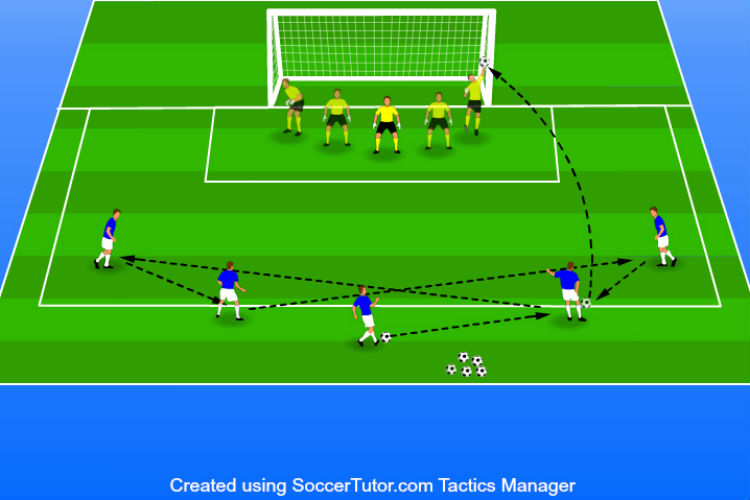
Instructions:
- The extra players start the activity by passing the ball between each other.
- The goalkeeper follows the ball and adjusts their position accordingly.
- After four passes, any player is free to take a shot on goal, especially if they feel the goalkeeper is out of position.
- The goalkeeper attempts to make a save on the ball.
- The goalkeeper bounces back up and the extra players start passing another ball to repeat the process.
- The goalkeeper should complete 4-6 repetitions before resting and retrieving the soccer balls.
- If there are multiple goalkeepers, have them rotate immediately after a round ends.
- Each goalkeeper should complete 2-3 rounds.
Variations:
One-touch – For advanced goalkeepers, the extra players must complete the passes and shot in one-touch. This makes the goalkeeper move and react more quickly.
Coaching Points:
- Instruct the goalkeepers to check their posts as they move to make sure they are positioned correctly.
- Remind the goalkeepers to focus on proper footwork when moving. Goalkeepers should not cross their feet and constantly set and reset their feet.
- Encourage the extra players to move the ball quickly and to be creative to give the goalkeeper more of a challenge.
6. Rapid Fire
How the Drill Works:
Eight soccer balls are positioned at the edge of the penalty box. Two players take turns shooting while one goalkeeper attempts to block one shot after another in rapid succession.
Purpose:
Develops a goalkeeper’s ability to quickly save one shot and be able to bounce back quickly and react to the next shot. Goalkeepers improve their footwork and reaction time.
Setup:
- One full-size goal.
- One goalkeeper positioned in front of the goal.
- Two more goalkeepers, coaches, or players are required to be the shooters. If there are multiple goalkeepers, have them rotate positions after each set of eight soccer balls.
- Place 8 soccer balls on the edge of the penalty box. If a penalty box is not being used, position the soccer balls about 18 yards away from the goal.
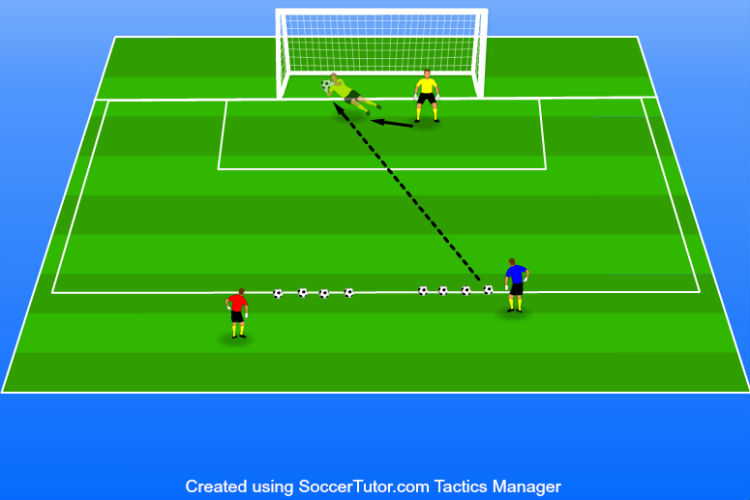
Instructions:
- To start the activity, one of the shooters takes a shot on goal while the goalkeeper attempts to make a save.
- As soon as the first shot is saved, or scored, the second shooters takes another shot.
- The shooters alternate taking shots until there are no more soccer balls left.
- The goalkeeper in goal must quickly react after each shot and move to attempt to save the next shot.
- After eight soccer balls have been shot, collect the soccer balls, and reset them on the penalty box line. If there is only one goalkeeper, give them plenty of rest time before repeating the same process for the next round. If there are multiple goalkeepers, have the next goalkeeper rotate in and repeat the process immediately.
- Repeat until each goalkeeper completes 3-4 rounds.
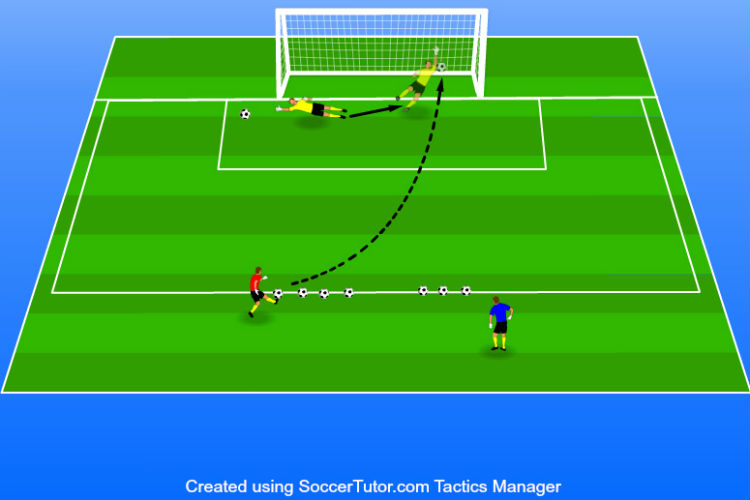
Variations:
Number of shots – Depending on the age and skill level of the goalkeeper, or goalkeepers, increase, or decrease the number of shots per round. More shots per round will demand more fitness and increase the goalkeeper’s stamina.
Shot angle and distance – Change the angle or distance of the shots to make the goalkeepers work on different saves.
Coaching Points:
- Challenge the goalkeeper to get back up on their feet as quickly as possible after each shot. This will give the goalkeeper the best chance of moving and reacting to the next shot.
- Remind the goalkeeper to catch as many shots as possible. This will build good habits to decrease the amount of rebound opportunities the goalkeeper gives up in a game.
- Educate the goalkeepers to focus on footwork and balance.
- Instruct the shooters to add more power to their shots as the goalkeeper get more comfortable. Accuracy should be stressed more than power for the shooters. Shooters should give the goalkeeper just enough time to get up and make a save on the next shot, but not enough time that the goalkeeper has time to reset.
7. Tip the Ball Over
How the Drill Works:
A goalkeeper starts on the 6-yard line and attempts to back pedal and tip the thrown ball over the crossbar.
Purpose:
Develops a goalkeeper’s ability to recover backwards and tip the ball over the crossbar when a catch is not possible. Improves the goalkeeper’s jumping and timing skills when recovering from being out of position.
Setup:
- A full-sized goal is needed.
- One goalkeeper starts on the 6-yard line facing forward.
- One extra goalkeeper, player, or coach is needed as a server. The server stands about 12-15 yards away from the goal with a good supply of soccer balls.
- The server starts with one ball in their hands.
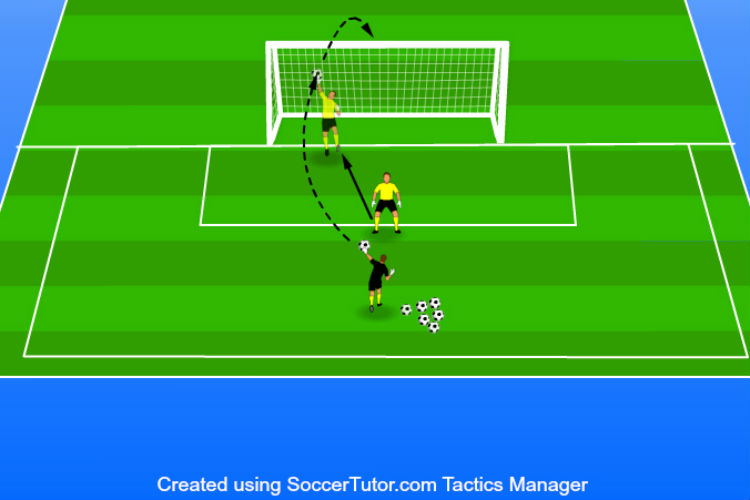
Instructions:
- The server starts the drill by throwing the ball over the goalkeeper and towards the goal in any direction. The server is aiming to get the ball to drop into the goal just below the crossbar.
- The goalkeeper must quickly move backwards and time their jump to tip the ball over the crossbar.
- Immediately after landing, the goalkeeper pops up and returns to the 6-yard line to repeat the process.
- The server should throw the next ball as soon as the goalkeeper gets to the 6-yard line. The server should vary the location the ball is thrown (center, left, or right).
- The goalkeeper should complete 6-8 repetitions before resting and collecting the soccer balls.
- If there is more than one goalkeeper have them rotate and complete the same process.
- Each goalkeeper should complete 2-3 rounds.
Variations:
Distance – Adjust the goalkeeper’s starting point depending on the age and skill level of the goalkeepers. The further away from goal, the more difficult the save.
Coaching Points:
- Teach the goalkeepers to not cross their feet when moving backwards. The proper footwork is the most important skill in this activity.
- Educate the goalkeepers to turn slightly in the direction of the ball as they move backwards. Goalkeepers should turn left slightly if the ball is over their left should and vice-versa for the right side.
- Challenge the goalkeepers to focus on the timing of their jumps and to jump off the foot closest to the goal.
- Teach the goalkeepers to tip the ball with the hand closest to the ball and to use the heel of the palm to tip the ball over the crossbar when possible.
- Instruct the goalkeepers to keep their eyes on the ball even after making contact with the ball.
8. Traffic Crosses
How the Drill Works:
A goalkeeper works around a series of mannequins as a ball is crossed into the penalty area for the goalkeeper to catch, or punch clear.
Purpose:
Develop a goalkeeper’s ability to move around defenders and catch a crossed ball out of the air. Goalkeepers improve their timing and confidence with balls served into a crowded penalty box.
Setup:
- Place 3-4 mannequins (flags, poles or passive players can also be used) around the 6-yard box.
- One full-size goal is needed on the end line of the penalty area.
- One goalkeeper starts inside the 6-yard box in front of the goal. If there are extra goalkeepers, use them as the servers, or have them stand to the side of the goal and rotate in every 4-6 repetitions.
- At least one extra goalkeeper, player, or coach is needed as the server. If there are more servers, have them create a line and rotate services. The server starts outside of the penalty box on one side.
- 5-8 soccer balls work best for this activity. This drill can be completed with just one soccer ball, but having extra helps keep the drill moving in the event of a miss-hit cross.
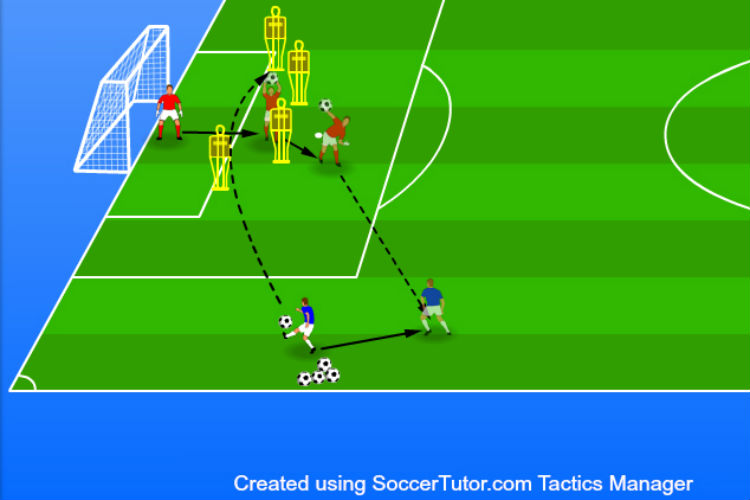
Instructions:
- The server starts the drill by crossing a ball, in the air, into the penalty box. The crosser should aim to deliver the ball 6-10 yards out from the goal so the goalkeeper must move to get to the ball.
- Once the cross is hit, the goalkeeper moves around the mannequins and times their jump to catch the ball at the highest point they can reach. The goalkeeper is free to punch the ball away as well, but catching the ball is the performed method.
- As soon as the goalkeeper catches it, they then throw the ball out as quickly as possible to the server as if they were starting the counter attack. This develops the goalkeeper’s distribution.
- Once the server and goalkeeper as reset positions, the process is repeated for the remaining repetitions.
- After 4-6 repetitions, the goalkeeper rests and retrieves any extra soccer balls that are not with the server. If there are extra goalkeepers, have them rotate in immediately and begin their turn.
- Complete at least 3 rounds on one side before switching sides and repeating the process.
Variations:
Active attackers – Instead of using mannequins, add two active players inside the penalty area who are attempting to score on each cross.
Different crosses – Switch up the services and where they are serviced from. Have the crossers drive, loft, or curl crosses in from different angles along the outside of the penalty area.
Coaching Points:
- Challenge the goalkeepers to focus on the ball while being aware of the mannequins or players. Goalkeepers should maintain eye contact on the ball and attack the ball.
- The goalkeepers should quickly decide whether they can win the ball with a catch, or punch, or if they need to stay inside the goal. Some crosses will be too far away from the goal for a goalkeeper to commit to. Have goalkeepers find their range.
- Educate the goalkeepers to make a full commitment to their decision so that they do not get stuck in the middle. Goalkeepers need to quickly, and fully commit to a decision.
- Challenge the goalkeepers to attack the ball quickly and decisively.
- Goalkeepers should time their jumps so that they are catching the ball at the top of their jump. The proper jumping technique is jumping off one leg while the other leg bends and uses the knee to protect them from incoming players.
- Teach the goalkeepers to punch the ball as far away as possible whenever they are unsure they can cleanly catch the ball.
9. Turn, Find, Dive
How the Drill Works:
On the command, a goalkeeper turns around to locate the target ball in the six soccer balls that are tossed towards them. The goalkeeper must quickly find the target ball and then quickly dive to recover it.
Purpose:
Develops a goalkeeper’s vision and reaction time. Goalkeepers improve their footwork and agility as well as they move to attack the target ball.
Setup:
- Use one full-size goal. This activity can also be completed using cones, or sticks, set up using the same dimensions as a full-size goal.
- One goalkeeper starts in the goal, or in-between the sticks. The goalkeeper starts facing away from the field.
- Six soccer balls are needed. One soccer ball needs to be a different color than the other five soccer balls. This soccer ball will be the target ball.
- Three extra goalkeepers, players, or coaches are needed as servers to complete this activity. The three servers stand on the 6-yard line with one soccer ball in each hand, facing the goalkeeper’s backside. One server will have the target soccer ball.
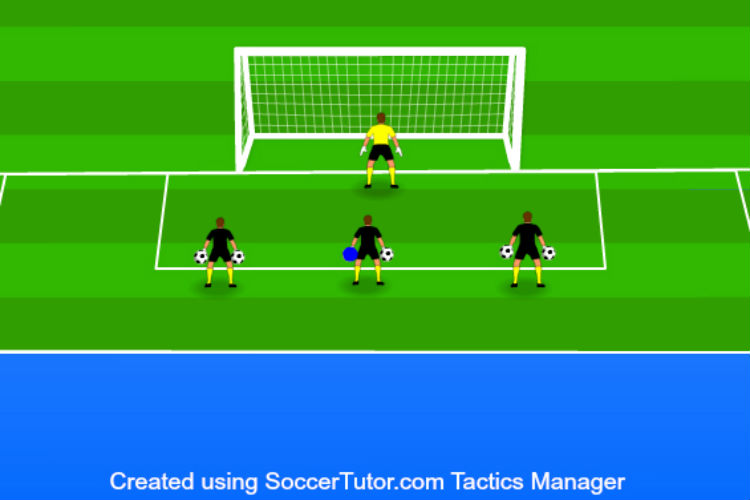
Instructions:
- On the coach’s signal, the servers randomly throw/toss their soccer balls into the 6-yard area in front of the goal.
- The coach then immediately shouts “Go!” and the goalkeeper must quickly turn, find the target ball, and dive to collect the ball.
- Servers collect the soccer balls and the goalkeeper resets their position by returning to the goal and turning away from the servers.
- As soon as the players and soccer balls are reset, repeat the process 4-6 more times before resting, or rotating the next goalkeeper in.
- Each goalkeeper should complete at least 10-12 repetitions, or 2-3 rounds.
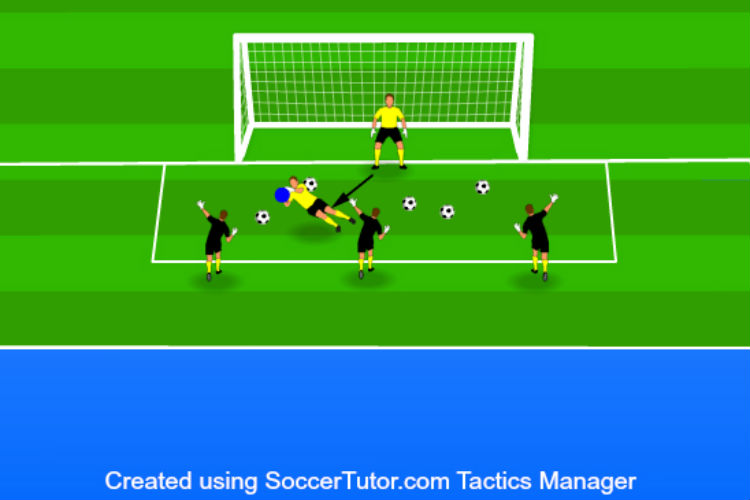
Variations:
Number of balls – For younger, or less experienced goalkeepers, start with just 3-4 soccer balls. Increase the number of soccer balls as the goalkeepers improve their reaction time.
Number of servers – If three servers is not possible, just use two servers with three soccer balls. One soccer ball in each hand, and one soccer ball at their feet.
Coaching Points:
- Teach the goalkeepers to stay light on their feet with their weight forward after their turn so they can attack the target ball quickly.
- Goalkeepers should focus on the proper footwork and agility when diving for the ball.
- Educate the goalkeepers to catch the ball first, using a good hand position, and then cushion the ball in when diving for the target ball.
- Remind the goalkeepers to not worry about landing before catching the ball.
- Challenge the goalkeepers to stay square while diving and land on the ground with their stomach behind the ball.
10. Under Pressure
How the Drill Works:
A goalkeeper starts from a goal kick and attempts to play out the approaching defenders’ pressure when possible. The goalkeeper and four extra players attempt to pass out of the back against three defenders.
Purpose:
Develops goalkeeper’s confidence and feet when placed under pressure. Goalkeepers increase their touch and decision making when completing this activity. Goalkeepers improve their ability to help their defenders play out of the opponent’s pressure and keep possession for their team.
Setup:
- One half of the field can be used for the drill.
- One full-sized goal should be placed on the end line.
- Set up two cone gates on the half line about 10-15 yards inside of each sideline. The cone gates should 3-4 yards wide.
- Seven extra players are needed. Works best if these players are field players. Four players should be given matching colored vests and will be on the goalkeeper’s team. The other three players will be the defending team and should be given a different jersey color then the attacking team.
- Place a line of cones 15 yards off the edge of the penalty box. This will be the line the three defenders must start behind.
- The four players on the goalkeeper’s team should get into a 3-1 formation with three defenders spread across the width of the field and one midfielder just in front of them.
- The goalkeeper starts with the ball inside the 6-yard box. All the extra soccer balls should be kept inside the goalkeeper’s goal.
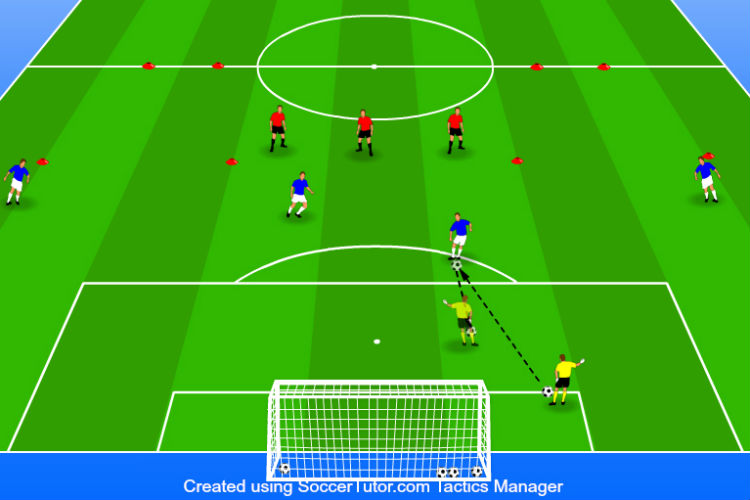
Instructions:
- The goalkeeper starts the drill by passing the ball to one of their teammates outside the penalty box.
- The receiving player passes the ball directly back to the goalkeeper.
- As soon as the receiving player touches the ball, the three defenders are free to move in front of their cone line and put the other team under pressure.
- The goalkeeper receives the ball from their teammate and attempts to pass and move with their teammates to play out of the defender’s pressure. The goalkeeper and field players attempt to pass, or dribble the ball through the two gates on the half-line.
- The three defenders move and attempt to steal the ball and score on the other team.
- If a goal is scored, or the ball goes out-of-bounds, for either team, the players reset and the goalkeeper restarts the activity with a goal kick.
- The process is repeated for 4-6 repetitions before goalkeepers rest, or rotate positions. Field players should also switch roles every 4-6 repetitions.
- Each goalkeeper should complete two rounds.
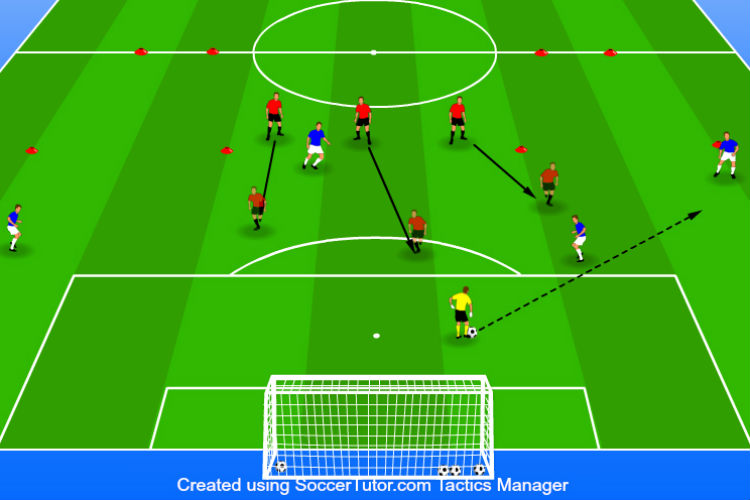
Variations:
Add or subtract players – Add more, or less, attackers, or defenders. Switch up the numbers and numbers advantages.
Coaching Points:
- Instruct the goalkeepers to use their first touch to move the ball away from the approaching defender.
- Remind the goalkeepers to keep their eyes up to see the field and where the ball should be passed.
- Educate the goalkeepers on the right time to play versus the right time to just kick the ball up field and out of danger.
- Encourage the goalkeepers to use the inside of their foot to clear the ball up the field. This part of the foot is bigger than the laces and is a safer decision.
- Teach the goalkeeper’s team to constantly move and find good passing angles for each other. There will be spaces to play, but players will need to look around and move into them to help keep possession of the ball and break the defenders high pressure.
- Challenge the field players to compete to win the ball and to not lose the ball.
11. Mid-Range Passing
How the Drill Works:
The goalkeeper practices chipping the ball mid-distance over obstacles, simulating build-from-the-back scenarios from games. Trajectory and accuracy are key as the ball must travel over mannequins and into various grids.
Purpose:
The main point of this drill is to develop mid-range passing abilities among goalkeepers, feeding into the build-from-the-back approach most teams now use. Goalies work on perfecting height and distance by chipping the ball over obstacles and into grids. This helps with goal kicks and live match scenarios.
Setup:
This drill works best when you have approximately half a field available.
Ideally, you’ll have 9 balls for each round. Alternatively, you’ll need someone to round up the balls after the goalkeeper takes a kick.
Set up three five-yard grids across the field between the edge of the penalty box and the halfway line (as shown in the graphic).
Set up mannequins on the edge of the penalty box to block direct access to each of the cone grids.
If you don’t have mannequins, use poles or large obstacles (a player or coach can stand in the way either).

Instructions:
The goalkeeper stands inside their six-yard box with multiple balls next to them (ideally, nine).
The goalkeeper has three attempts to chip the ball into each cone grid (nine kicks in total).
With mannequins or obstacles in the way, the goalie must be able to chip the ball over them or curl it around them to find the target.
Take note of the number of successful kicks in each round.
Repeat the entire drill three times.
If you have multiple goalkeepers on your team, rotate them every round.
Variations:
Competition - Create a competition to see who gets the most accurate kicks (you can include outfield players as the skills are transferable).
Rolling ball - Repeat the drill with a rolling ball.
Change up the grid - Change the positions of the cones and mannequins to work on passing at various distances.
Coaching points:
If you haven’t practiced this type of drill before, you may find that your goalkeepers change their technique by pulling back power and not following through. However, this is not the right approach. Teach them to control their power and trajectory while still following through, paying attention to technique.
If your players struggle to bypass the obstacles, remove them at first.
This drill is more difficult than it looks so have patience with your players.
12. Goalkeeper Counters
How the Drill Works:
After receiving a pass from the coach, the goalkeeper kicks the ball upfield into the path of onrushing teammates. The drill replicates fast counterattacks started by the goalkeeper. It also helps outfield players to learn the correct movements to spring counters.
Purpose:
The aim of this drill is to teach your goalkeepers how to execute counterattacks. In addition to working on the technical aspects of counterattacks, such as kicking, this exercise develops quick reactions and vision. Since outfield players are involved, the drill can be used to practice counterattack sequences that you will use in a game.
Setup:
Depending on how old your players are and how far they can kick a ball, you may need a full or half field.
Place three cones across the field between the penalty box and the halfway line (one to the left, one in the center, and one to the right).
The goalkeeper stands inside the penalty area.
The coach stands on the edge of the penalty box with multiple balls.
One outfield player stands at each of the cones (you can rotate outfield players after each round).
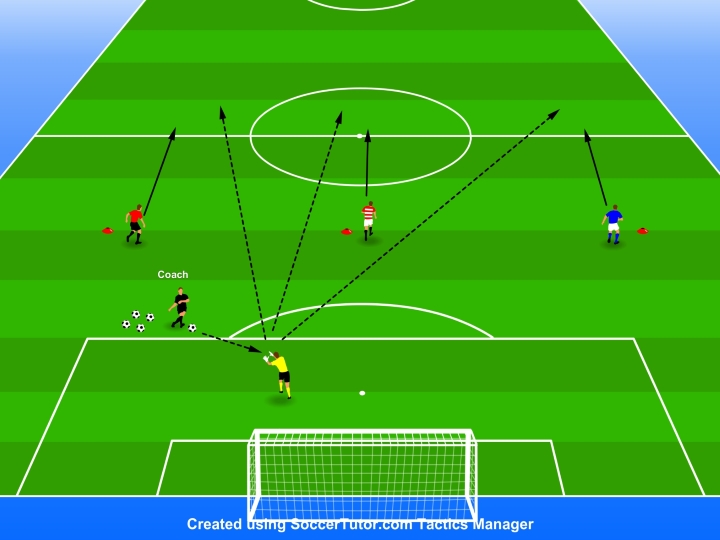
Instructions:
The goalie stands around the penalty spot, anticipating a pass.
The coach kicks off the drill by throwing the ball into the air toward the goalie.
Once the keeper catches the ball, the outfield players begin to run upfield, triggering the counter.
After gauging the timing and distance, the goalkeeper launches a long pass into the path of one of the players. The longer the pass, the better.
Repeat the drill nine times, kicking the ball to each of the players three times.
Take note of the number of accurate passes.
If you have multiple goalkeepers, rotate them in each round.
Variations:
Switch positions - Change the positions of the outfield palyers to practice counterattacks from different positions.
Change the passing angle of the coach - Switch the starting point of the coach so the goalie practices catching the ball from various angles.
Goalkeeper throws - Repeat the drill but use throws instead of kicks.
Rolling ball - Repeat the drill but with kicks from the ground rather than the hands.
Coaching points:
The ball should meet the run of the outfield player but it shouldn’t land too far ahead of them (as it would likely be intercepted in a real game).
To launch an effective counter, the ball should travel far, so encourage goalkeepers to try to kick the ball into the opponent’s half.
Take note of whether your goalkeeper is better at kicking to a particular side. While it’s important for them to work on their weaknesses, perhaps you should focus on the strong side kicks during games.
Ball control from the outfield players is also crucial so pay attention to the first touches of your outfield players.
More Resources:
We've compiled all 11 of our "soccer drills" posts into one resource page.
Check out my two other posts on dominating as a goalie here and here.

